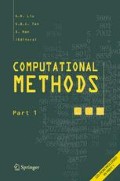Abstract
Phylogeny reconstruction is a difficult computational problem, because the number of possible solutions increases with the number of included taxa. For this reason, phylogenetic inference methods commonly use clustering algorithms or heuristic search strategies to minimize the amount of time spent evaluating non-optimal trees. Even heuristic searches can be painfully slow, especially when computationally intensive optimality criteria such as maximum likelihood are used. I describe here a genetic programming to heuristic searching that can tremendously reduce the time required for maximum-likelihood phylogenetic inference, especially for data sets involving large numbers of taxa, and we confirm its availability by experiments.
Access this chapter
Tax calculation will be finalised at checkout
Purchases are for personal use only
Preview
Unable to display preview. Download preview PDF.
REFERENCES
R.D.M. Page and E.C. Holmes (1998), Molecular Evolution: A Phylogenetic Approach. Blackwell Science Ltd, Oxford.
O.L. Paul (1998), A genetic algorithm for maximum-likelihood phylogeny inference using nucleotide sequence data. Molecular Biology and Evolution, 1, 15, pp. 277–283.
C.B. Congdon (2002), Gaphyl: An evolutionary algorithms approach for the study of natural evolution. In: Proceedings of the Genetic and Evolutionary Computation Conference (GECCO2002), MorganKaufmann, San Francisco, CA, pp. 1057–1064.
A. Rzhetsky and M. Nei (1993), Theoretical foundation of the minimum-evolution method of phylogenetic inference. Molecular Biology and Evolution, 10, pp. 1073–1095.
Author information
Authors and Affiliations
Editor information
Editors and Affiliations
Rights and permissions
Copyright information
© 2006 Springer
About this paper
Cite this paper
Lv, H., Zhou, C., Zhou, J. (2006). GENETIC PROGRAMMING FOR MAXIMUM-LIKELIHOOD PHYLOGENY INFERENCE. In: LIU, G., TAN, V., HAN, X. (eds) Computational Methods. Springer, Dordrecht. https://doi.org/10.1007/978-1-4020-3953-9_37
Download citation
DOI: https://doi.org/10.1007/978-1-4020-3953-9_37
Publisher Name: Springer, Dordrecht
Print ISBN: 978-1-4020-3952-2
Online ISBN: 978-1-4020-3953-9
eBook Packages: EngineeringEngineering (R0)

